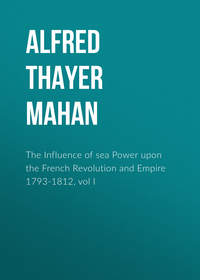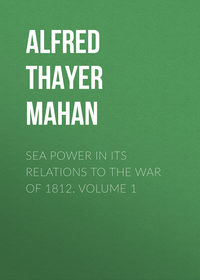 полная версия
полная версияПолная версия
Sea Power in its Relations to the War of 1812. Volume 2
Having decided that the enterprise against Kingston was not feasible, Brown fell into the not unnatural mistake of construing the Secretary's other letter to present not merely a ruse, but an alternative line of action, more consonant to his active martial temper than remaining idle in garrison. Accordingly, he left Sackett's with his two thousand, an event duly chronicled in a letter of Drummond's, that on Sunday, March 13, three thousand five hundred left Sackett's for Niagara; a statement sufficiently characteristic of the common tendency of an enemy's force to swell, as it passes from mouth to mouth. The division had progressed as far as the present city of Syracuse, sixty miles from Sackett's, and Brown himself was some forty miles in advance of it, at Geneva, when one of his principal subordinates persuaded him that he had misconstrued the Department's purpose. In considerable distress he turned about, passing through Auburn on the 23d at the rate of thirty miles a day, so said a contemporary newspaper,276 and hurried back to Sackett's. There further consultation with Chauncey convinced him again that he was intended to go to Niagara, and he resumed his march. Before April 1 he reached Batavia, where his instructions read he would receive further orders. General Scott was already at Buffalo, and there the troops were placed under his immediate charge for organization and drill; Brigadier-General Gaines being sent back to command at Sackett's, where he arrived April 10.
At this moment Chauncey was undergoing his turn of qualms. "The enemy," he wrote the following day, "have prepared a force of three thousand troops, with gunboats and a number of small craft, to attack the harbor the moment the fleet leaves it. They may, however, be determined to make the attack at all hazards, and I am sorry to say our force is but little adapted to the defence of the place. There are not a thousand effective men besides the sailors and marines."277 His information was substantially correct. Drummond had arranged to concentrate three thousand men from the north shore of the lake; but he wanted besides eight hundred from the peninsula, and for lack of these the project was abandoned.
The movement of Brown's small contingent to Buffalo, though contrary to the intention of the Government, may be considered to have opened the campaign of 1814; destined to prove as abortive in substantial results as that of the year before, but not so futile and inglorious to the American arms. The troops engaged had been formed under the skilful organization and training of Scott. Led by Brown, who, though not an educated soldier nor a master of the technicalities of the profession, was essentially an aggressive fighting man of masculine qualities, they failed indeed to achieve success, for which their numbers were inadequate; but there was no further disgrace.
Wilkinson, indeed, in his district, contrived to give to the beginning of operations the air of absurdity that ever hung round his path. Although he was the senior officer on the whole frontier, the Department had not notified him of Brown's orders. This vicious practice of managing the campaign from a point as distant as Washington then was, ignoring any local centre of control, drew subsequently the animadversion of the President, who in a minute to the Secretary remarked that "it does not appear that Izard,"—Wilkinson's successor,—"though the senior officer of the district, has been made acquainted with the plan of operations under Brown."278 On the present occasion Wilkinson explained that, hearing of Brown's march by common report, and having ascertained that the enemy was sending re-enforcements up the St. Lawrence, he undertook an incursion into Lower Canada as a diversion against such increase of the force with which Brown must contend.279 His enterprise was directed against La Colle, a few miles from Plattsburg, within the Canada boundary; but upon arriving before the position it was found that the garrison were established in a stone mill, upon which the guns brought along could make no impression. After this somewhat ludicrous experience, the division, more than three thousand strong, retreated, having lost over seventy men. The result was scarcely likely to afford Brown much relief by its deterrent influence upon the enemy.
This affair happened March 30, and in the course of the following month Wilkinson was finally superseded. He was succeeded by General Izard, who assumed command May 4, and remained in the neighborhood of Champlain, while Brown continued immediately responsible for Sackett's Harbor and for the force at Buffalo. On April 14 Yeo launched two new ships, the "Prince Regent" of fifty-eight guns and the "Princess Charlotte" of forty; and he at the same time had under construction one destined to carry one hundred and two heavy guns, superior therefore in size and armament to most of the British ocean navy, and far more formidable than any in which Nelson ever served. Fortunately for the Americans, this vessel, which Yeo undertook without authority from home, was not ready until October; but the former two, added to his last year's fleet, gave him for the moment a decided preponderance over Chauncey, who also was building but had not yet completed.
Under these circumstances the project of attacking Sackett's in force was again most seriously agitated among the British officials, military and naval, upon whom the destitution of the Niagara peninsula pressed with increasing urgency. Such an intention rarely fails to transpire, especially across a border line where the inhabitants on either side speak the same tongue and are often intimately acquainted. Desertion, moreover, was frequent from both parties. The rumor brought Brown back hastily to the place, where he arrived April 24. The enemy, however, again abandoned their purpose, and after embarking a considerable body of troops turned their arms instead against Oswego.
It will be remembered that the mildness of the winter had prevented the transport of guns and stores by land, and made necessary to accumulate them by water carriage at Oswego, whence there remained the lake voyage to Sackett's Harbor. This, though a coasting operation, involved much danger while the enemy possessed naval control. Meanwhile Oswego became a somewhat congested and much exposed intermediate station, inviting attack. Chauncey therefore had taken the precaution of retaining the most important articles, guns and their equipment, at the falls of the Oswego River, some twelve miles inland. The enemy's change of plan becoming suspected, Brown detached a small party—two hundred and ninety effectives—to defend the place, in conjunction with the few seamen already there. The British fleet appeared on May 5, but the attack was not made until the following day, weather conditions being unfavorable. Despite the unprepared state of the defences characteristic of the universal American situation, on both lakes and seaboard, in this singular war, the officer in command offered a spirited resistance, inflicting considerable loss; but the urgency to preserve his force, for the superior necessity of protecting under more favorable circumstances the valuable property in the rear, compelled him to retreat, to escape the risk of being surrounded and captured. He accordingly drew off in good order, having lost six killed and thirty-eight wounded; besides twenty-five missing, probably prisoners. The casualties of the British, by their official reports, were eighteen killed and seventy-three wounded. They kept possession of the town during the night, retiring next day with two small schooners, over two thousand barrels of provisions, and a quantity of cordage.280 The most serious loss to the Americans was that of nine heavy cannon; but the bulk of the armament for the fleet remained safe at the falls.
After this Yeo took position with his squadron off Sackett's Harbor, where the Americans on May 1 had launched a new big ship, the "Superior", to carry sixty-two guns, thirty-two long 32-pounders, and thirty carronades of the same calibre. Besides her there was building still another, of somewhat smaller force, without which Chauncey would not consider himself able to contend with the enemy.281 On the 20th of the month he reported that "five sail were now anchored between Point Peninsula and Stoney Island, about ten miles from the harbor, and two brigs between Stoney Island and Stoney Point, completely blocking both passes." He added, "This is the first time that I have experienced the mortification of being blockaded on the lakes."282 The line thus occupied by the enemy covered the entire entrance to Black River Bay, within which Sackett's Harbor lies. This situation was the more intolerable under the existing necessity of bringing the guns by water. Drummond, whose information was probably good, wrote at this period that not more than fifteen of the heavy cannon needed for the new ships had arrived, and that they could come from Oswego only by the lake, as the roads were impassable except for horsemen. Carronades, cordage, and other stores were going on by wagon from Utica, but the long guns which were imperatively required could not do so.283
American contrivance proved equal to the dilemma, and led to a marked British misadventure. A few miles south of Black River Bay, and therefore outside the line of the British blockade, there was an inlet called Stoney Creek, from the head of which a short land carriage of three miles would strike Henderson's Bay. This, like Sackett's, is an indentation of Black River Bay, and was well within the hostile ships. The transit from Oswego to Stoney Creek, however, remained open to an enemy's attack, and to be effected without loss required address, enterprise, and rapidity of movement. The danger was lessened by the number of streams which enter Mexico Bay, the deep bight formed by the southern and eastern shores of Lake Ontario, between Oswego and Sackett's. These, being navigable for batteaux, constituted a series of harbors of refuge.
Chauncey directed all the lighter equipment to be turned back from Oswego River to North Bay, on Lake Oneida, and the long guns to be placed in batteaux, ready to move instantly, either up or down, as the movements of the enemy or a favorable opportunity might determine. Discretionary power to act according to circumstances was then given to Captain Woolsey, in local command on the Oswego. Woolsey made great parade of his preparations to send everything, guns included, back across the portage from the river, to North Bay. The reports reached Yeo, as intended, but did not throw him wholly off his guard. On May 27 Woolsey despatched an officer in a fast pulling boat to reconnoitre the coast, while he himself went with the requisite force to the falls. On the 28th the batteaux, nineteen in number, carrying twenty-one long 32-pounders, and thirteen lighter pieces, besides ten heavy cables, were run over the rapids, reaching Oswego at sunset. The lookout boat had returned, reporting all clear, and after dark the convoy started. Besides the regular crews, there were embarked one hundred and fifty riflemen from the army. The next morning at sunrise one batteau was missing, but the other eighteen entered the Salmon River, over twenty miles from Oswego. The nights were short at that season, and the boats heavy; moreover there had been drenching rain.
At Salmon River, a party of one hundred and twenty Oneida Indians joined, who were to move along the coast on the flank of the convoy through the next stage of the journey, by day, to support the defence should the approach of an enemy compel refuge to be sought in one of the creeks. As soon as they had taken up their march the batteaux also started, and at noon, May 29, reached Big Sandy Creek, ten miles further on, but eight miles short of the final destination at Stoney Creek. Here greater care became necessary, on account of the nearness of the enemy's fleet; and while awaiting information the division moved two miles up the Big Sandy, where it anchored.
The missing batteau, carrying two long 24's and a cable, had been captured; having wandered away from the rest of the detachment, despite the watchful care exerted to keep them together. Her crew betrayed the extent of the operation of which they formed part, and a division of boats was sent in quest, in charge of two captains of the blockading vessels; the senior officer of the whole being Commander Popham. On his way Popham fell in with another group of armed boats, which he took under his command, raising his total to three gun-vessels and four smaller boats, with near two hundred seamen and marines. Certain intelligence being received that the convoy had entered the Big Sandy, he steered thither, arriving off its mouth soon after daylight of May 30. A reconnaissance on shore discovering the masts of the batteaux plainly visible over a marsh, with apparently no intervening forest, an immediate attack was decided. Having landed a party of flankers on either bank, the expedition proceeded up stream with due caution, firing an occasional round into the brush to dislodge any possible ambush. It was not known that an escort, beyond the usual crews, had accompanied the movement. Such a precaution might indeed have been inferred from the importance of the object; but the same reason naturally, and not improperly, decided Popham that considerable risk was justifiable in order to frustrate his enemy's purpose.
Woolsey was already forewarned of his coming. At 2 A.M. of the same day, May 30, he had received from Chauncey an express, in accordance with which an officer was sent out upon the lake, to reconnoitre towards the entrance of Black River Bay. At six o'clock he returned, having been seen and pursued by some of Popham's division. The riflemen and Indians were now advanced half a mile below the batteaux, where they found cover and concealment in the woods. At eight the British guns were heard. At nine a re-enforcement of cavalry and light artillery arrived from Sackett's Harbor, but it was decided that they should remain by the batteaux, the force already below being best adapted for bush fighting. Towards ten o'clock the riflemen and Indians attacked; a circumstance attributed by Captain Popham to an accident befalling the 68-pounder carronade in the bow of the leading gunboat, which compelled her to turn round, to bring into action her stern gun, a 24-pounder. "The enemy thought we were commencing a retreat, when they advanced their whole force, one hundred and fifty riflemen, near two hundred Indians, and a numerous body of militia and cavalry, who soon overpowered the few men I had.... The winding of the creek, which gave the enemy a great advantage in advancing to intercept our retreat, rendered further resistance unavailing." The entire detachment surrendered, having had fourteen killed and twenty-eight wounded; besides whom two captains, six lieutenants, and one hundred and thirty-three seamen and marines remained prisoners. The American loss was but two wounded; a result showing clearly enough the disadvantage under which the British labored.
This affair has been related in detail,284 because, although on a small scale, it was actually one of great consequence; but yet more because it illustrates aptly one kind of those minor operations of war, upon the success of which so much greater matters turn. The American management throughout was admirable in its detailed foresight and circumspection. To this was due the trivial loss attending its final success; a loss therefore attesting far greater credit than would the attaining of the same result by lavish expenditure of blood. To Captain Popham must be attributed both enterprise and due carefulness in undertaking an advance he knew to be hazardous, but from which, if successful, he was entitled to expect nothing less than the capture of almost the entire armament of a very large ship. In such circumstances censure because of failure is unjust, unless the risk is shown to be taken reckless of due precautions, which was not the case in this instance. Yeo, whose deficiency in seamen was reported at two hundred and seventy-nine,285 three days after this affair, appears to have been more exasperated by the loss of the men than sensible of the merit of his subordinate. He had charged him not to enter any creek in the endeavor to capture the stores, and apparently laid the disaster to disregard of this order. The subsequent customary court martial decided that Popham, having greatly re-enforced himself by junction with a division of vessels, in a manner which Yeo could not have contemplated, was fully justified by the importance of preventing the convoy from reaching Sackett's Harbor. The court regretted that Sir James Yeo should have used such reproachful expressions in his letter to the Admiralty communicating Captain Popham's capture. Popham, and his second, Spilsbury, were included in the promotions of a year later.
Soon after this mishap Yeo abandoned the immediate blockade of Sackett's Harbor, returning to Kingston June 6. The recent experience demonstrated that it would be impossible to prevent the forwarding of supplies by the mere presence of the fleet at the mouth of the port. The armament of the "Superior" had arrived despite his efforts, and her speedy readiness to take the lake was assured. An exchange of letters between himself and Drummond as to his proper course286 led to the conclusion that the blockade had not had all the effect expected; and that, in view of the large re-enforcements of men coming forward from England, the true policy was to avoid battle until the third new ship, the "St. Lawrence" of one hundred and two guns, should be ready. "The enemy," wrote Yeo, "are not in sufficient force to undertake any expedition in the face of our present squadron, but any disaster on our side might give them a serious ascendancy." Drummond, who had rejoiced that the blockade "assures us a free intercourse throughout the lake," concurred in this view. "I have no hesitation in saying that there exists at present no motive or object, connected with the security of Upper Canada, which can make it necessary for you to act otherwise than cautiously on the defensive," until the large ship is ready or other circumstances arise.
On June 7 the Cabinet of the United States held a meeting, in which was settled the plan of campaign on the northern frontier;287 where alone, and for a brief period only, an expected superiority of numbers would permit offensive operations. As in the year before, the decision, in general terms, was to direct the main effort against the enemy's right and centre, Mackinac and the Niagara peninsula, instead of against his left, at Montreal or Kingston. The principal movement was to be by a concentration near Buffalo of forces from New York and the western territory, which the Secretary of War estimated might place under Brown's command five thousand regular troops and three thousand volunteers. He had proposed that these, with the assistance of the Erie navy, should be landed on the coast between Fort Erie, at the entrance of the Niagara River, and Point Abino, ten miles to the westward. Thence they were to act against Burlington Heights, at the head of Lake Ontario, the tenure of which by Vincent in 1813, had baffled, on two occasions, the advance of the Americans, and maintained the land communications of the British with York (Toronto) despite their enemy's control of the water. The Secretary's anticipation was that, after gaining this position, the force could proceed along the north shore of the lake towards York, receiving its supplies by the fleet, which was expected to be ready by June 15. Chauncey himself stated June 8 that he would be ready by July 1, if men were sent him.288 On the 11th was launched a second new ship, the "Mohawk," to carry forty-two guns. The crew of the "Congress" was ordered up from Portsmouth, and part of them, with other re-enforcements, were reported to have arrived before June 20. June 24 Chauncey wrote, "I shall sail the first week in July to offer the enemy battle."289 He did not, however, take the Lake until August 1.
The Cabinet had approved the Secretary's suggestion, but extended the place of debarkation to be between Fort Erie and Long Point, eighty miles from the Niagara River, and well west of Burlington Heights. Subsidiary to this main attack, General Izard at Plattsburg was to make a diversion towards Montreal. Coincidently with these movements an expedition of four or five of the Erie fleet, with eight hundred to one thousand troops, should go against Mackinac; their first object, however, being Matchedash Bay, on Lake Huron, which was the seat of an incipient naval establishment, and the point of deposit for supplies proceeding to Mackinac from York by way of Lake Simcoe. This attempt to choke the communications of Mackinac, by holding a vital point upon their line, was to have its counterpart in the east by the provision of fifteen armed boats on the St. Lawrence, supported by posts on the river garrisoned by detachments from Izard's army, so as to intercept the water transport between Montreal and Kingston. It may be mentioned that this particular method had specially commended itself to both Yeo and Chauncey, as most suited to embarrass the British situation throughout the upper province. In a subsequent report to the Admiralty, Yeo characterized the failure of the Americans to do this as an extreme stupidity, which had lost them the war, but upon a repetition of which in future hostilities Great Britain should not rely.290 The importance of this intercourse is indicated by a mention of Chauncey's, that in the week before June 15 more than two hundred boats passed Ogdensburg for Kingston.291
All this, however, simply emphasizes the fact that the decisive point of attack was Montreal or Kingston; not the line between them, which would become useless if either fell. Still less could the Niagara peninsula, though a valuable link in a chain of communication from the lower to the upper lakes, compare in importance with either of the places named. It matters not that a chain is complete in itself, if it is severed from one of the extremities which it is designed to connect. As regards any attempt on the part of the Americans to interrupt the traffic, Drummond appears to have been satisfied with Yeo's promise that "every brigade of batteaux should have a suitable convoy of gunboats."
The Secretary of War, in his communication to the President before the Cabinet met, had indicated plainly his preference for leaving Mackinac alone and concentrating upon the central point of effort, Niagara or Burlington. "Burlington and York carried, a barrier is interposed which completely protects Detroit and Malden, makes doubtful and hazardous the enemy's intercourse with the western Indians, reduces Mackinac to a possession perfectly useless, renders probable the evacuation of Fort Niagara, and takes from the enemy half his motive for continuing the naval conflict on Lake Ontario. On the other hand, take Mackinac, and what is gained but Mackinac itself?"292 The reasoning was indisputable, although Armstrong acquiesced in the decision of the Cabinet. The main feature of the plan adopted, the reduction of Burlington Heights and a successful advance on York, was of doubtful issue; but, if successful, the vital end of the chain upon which Mackinac depended for existence dropped useless to the ground. All side enterprise that did not directly contribute to this decisive movement should have been discarded in favor of concentration upon Brown's army, to which its execution was committed, and the actual strength of which was insufficient for the task. At the opening of the campaign its total strength was four thousand seven hundred and eighty, of whom eight hundred and thirty were militia.293 On July 1 there were present for duty three thousand five hundred. There were also six hundred Indians of the Six Nations. In this impotent conclusion resulted the Secretary's estimate of five thousand regulars and three thousand volunteers.
On July 2 Brown announced to his troops that he was authorized by the Government to put them in motion against the enemy.294 He had decided to leave Fort Niagara, with its menace to his communications, in his rear, unguarded, and to throw his command directly upon the enemy on the west bank of the river. The crossing was made that night in two divisions; one landing opposite Black Rock, below Fort Erie, the other above that post, which surrendered July 3, at 5 P.M. The garrison numbered one hundred and thirty-seven. From there Brown proposed to turn north and advance towards Ontario, where he hoped to join hands with the navy, which was expected by him, and by the Government, to be on hand to co-operate. This expectation was based on Chauncey's own assurance that he would take the lake on July 1, if supplied with men, who were known since to have arrived. It does not appear, however, that he had received specific instructions as to the course he was intended to follow; and, in assuming that he would go to the head of the lake, for direct co-operation, the Government and the general were reckoning without their host, and in ignorance of his views. He was as loath to leave Kingston and Sackett's in his rear, unwatched, as Brown was willing to take the same risk with regard to Niagara. It was a profound difference of temperament in two capable men, to whom the Government failed to impart the unifying element of orders.











